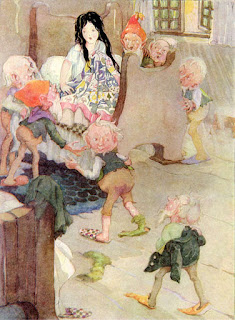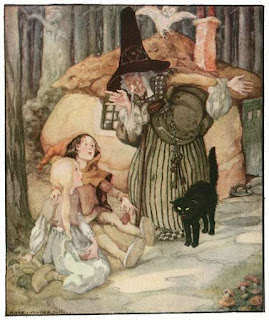The Frog King in Pictures
The Frog King - Free Pictures
The Frog King is often (especially in English-speaking countries) titled The Frog Prince and sometimes (especially in Eastern Europe) The Princess and the Frog. Brothers Grimm, who put it as the number one in their iconic collection, subtitled it The Iron Henry, including the faithful servant in the spotlight. It's known in numerous variations with essentially the same plot. The princess plays with her favorite toy. It falls into the water, and the frog brings it back. In return, she promises to eat with him at the same table, play with the same toys, and sleep in the same bed. The bed was omitted in all later versions by the Grimms. They didn't want to see the tale as a growing-up story with a girl learning to see her future husband as a nice man but tried to focus on the importance of keeping one's promise. The importance of a given word is quite often in classic fairy tales, including Bluebeard and The Goose Maid.
Anne Anderson (1874-1952)
The illustration with the princess and the frog sitting at the table because of her promise comes from the book Fairy Tales of the Brothers Grimm, published by The Childrens’ Press, Glasgow, 1933.
Anne Anderson created the image in Art Nouveau style with emphasized curves and bright living colors.
Edward Frederick Brewtnall (1846-1902)
The next image doesn't come from the book. It's a watercolor painting from 1880.
Edward F. Brewtnall decided to present the water in a fountain as a running force of life, emphasizing it with the red clothes of the princess.
Walter Crane (1845-1915)
Walter Crane created numerous picture books based on popular fairy tales and nursery rhymes. He also illustrated ABC books and wrote a few by himself. He was not just an illustrator. Crane took care of design and typography, as well.
The same story with the same illustrations was reprinted several times and in different editions. This one comes from 1875, published by Routledge & Sons. The pictures dominate in the book, and the text is shortened and rhymed by Crane.
Jessie Mabel Pritchard Dearmer (1872-1915)
Born Jessie Mable Pritchard White, she married Reverend Percival (Percy) Dearmer in 1892. She started her artistic career later and signed her works mostly as Mrs. Percy Dearmer or Mabel Dearmer.
The illustration above is titled The Frog Princess and was published in the magazine The Parade in 1897.
Richard Flockenhaus (1876-1943)
The selected illustration is one of five color pictures from The Most Beautiful Fairy Tales of the Brothers Grimm and subtitled Selected for Young People by Richard Lorenz.
It was published by Verlag Jugendhort, Berlin, in 1910.
Wanda Gag (1893-1946)
Wanda Gag was an American artist who explored her German roots, not only by illustrating but also by translating and adapting Grimms' fairy tales.
Her versions were more child-friendly and humorous than the originals. The Frog King was changed into The Frog Prince. The illustration was published in 1936 by Coward-McCann, New York. The book was titled Tales from Grimm and featured sixteen fairy tales.
Warwick Goble (1862-1943)
Warwick Goble was best known for his illustrations of fairy tales from more exotic countries, like India or Japan. This one is one of not so rare exceptions. It was published in 1913 by MacMillan.
The Frog Prince is just one of 32 (!) color plates in The Fairy Book.
The Frog Prince is just one of 32 (!) color plates in The Fairy Book.
Oskar Herrfurth (1862-1934)
Oskar Herrfurth was one of the great masters of picture postcards in the Golden Age of illustration.
The presented card is the first in a series of six.
Paul Hey (1867-1952)
Paul Hey was also a well-known postcard designer. He was probably even more specialized in this area than his contemporary Oskar Herrfurt. But this illustration comes from the book titled German Fairy Tales.
We don't know when the German fairy tales were published, but around 1930 seems a good estimation.
Daniel Hock (1858-1934)
The next painting by Austrian artist Hock is dated 1930.
We don't know much about Hock, and Hohneck is a similar case.
Maria Hohneck (1866-1949)
Maria was the daughter of the painter Adolf Hohneck. She was especially productive from 1895 to 1915.
This illustration is from Children's and Household Tales, published by Gustav Weise Verlag Stuttgart, Munich.
Gilbert Penrose James (1865-1941)
Gilbert James was very productive, but the quality of his work varied greatly. The next illustration is from the period when he had an extreme amount of work.
You can check this unusual fairy tale (one of six in the selection) here: https://gilbertpenrosejames.weebly.com/frog-prince.html.
Willy Juttner (1886-1940)
The next image comes from Of Kings and Royal Children.
It's amazing how much is possible to achieve with such a limited amount of colors.
Jessie Marion King (1875-1949)
This oil-on-panel was created in 1913. Today, it's part of the collection in Glasgow Museums.
Originally, it was a part of four panels designed for a children's room. We don't know what happened with the other three panels, but you can learn a bit more about the artist here: https://jessie-m-king-fairy-world.carrd.co/.
Heinrich Lefler (1863-1919) and Joseph Urban (1872-1933)
These artists were brothers-in-law. They created a lot of illustrations together.
Lefler was mostly in charge of the composition, and Urban took care of the borders and decorative elements.
Maximilian Lenz (1860-1947)
All kinds of cards became popular at the turn of the 19th to the 20th century. Next was created for the famous chocolate company Stollwerck.
It is dated 1900. It seems the only trip into the world of fairy tales or picture cards for this Austrian painter.
William Henry Margetson (1861-1940)
Margetson was a British painter who created with oils and watercolors. He became a successful illustrator in later years.
Paul Friedrich Meyerheim (1842-1915)
Paul Meyerheim was one of the German painters who later became illustrators.
Frog King by Meyerheim is from 1893.
Karl Rudolf Gustav Muhlmeister (1876-194?)
The date of death of Karl Muhlmeister is unknown. It has to be between 1942 and 1945.
The illustration above is dated 1930.
Arthur Rackham (1867-1939)
Arthur Rackham illustrated Grimms' fairy tales on several occasions. His take on the Frog King (or Prince) can be seen below.
The first one is from The Fairy Tales of the Brothers Grimm, published in 1909. The second one is from The Arthur Rackham Book of Pictures, published in 1913.
In 1915, the Golden Age of picture books ended. Arthur Rackham was the greatest name of the time.
Charles Robinson (1870-1937)
Charles Robinson was a British illustrator who loved creating in the Art Nouveau style. His Frog Prince is a fine example.The presented illustration was published in 1911 by Blackie and Son in The Big Book of Fairy Tales. It's the only color illustrations for this story, but there are around ten black and white drawings, too.
Check them out: https://charlesrobinsonillustrator.blogspot.com/2023/11/frog-prince.html.
Fritz Schon (1871-1952 or 1953)
Fritz Schon created a trading card with a scene from The Frog King for Palmin.
It's a collectible item, of course.Otto Schott (1847-1935)
This German illustrator is another tough one to decode. We just know for sure that his illustration of Frog King was published after World War 2.
There is no available data on when and why Schott's illustrations were created.
Wladyslav Skoczylas (1883-1934)
This large (75 cm x 80 cm) oil painting was made in 1908. It's displayed in the museum Sztuki in Lodz, Poland.
Skoczylas' painting has two titles: The fairy tale about the princess and the frog prince and the shorter The princess with a frog.
Elmer Boyd Smith (1860-1943)
The next illustration by an American artist comes from The Fairy Book (The best popular fairy stories selected and rendered anew), by Thomas Y. Crowell & Co. Publishers, New York.
The book was published in 1908.
Marianne Stokes (1855-1927)
Marianne Stokes was one of the leading female artists in the Victorian era. She was born Maria Leopoldine Preindlsberger in Austria and married Adrian Stokes, who was also a painter.
This oil on canvas measures about 50 cm x 50 cm. It's part of a private collection, just like most of Stokes' opus. The painting was made around 1890.
Edward Henry Wehnert (1813-1868)
The full title of the next illustration is The Frog Prince and the King's Daughter. Wehnert created it in 1901.
There is a plan to expand this page with more public-domain images. In the meantime, enjoy other vintage fairy tale pictures and share this post with other fairy tale lovers.































Komentarji
Objavite komentar